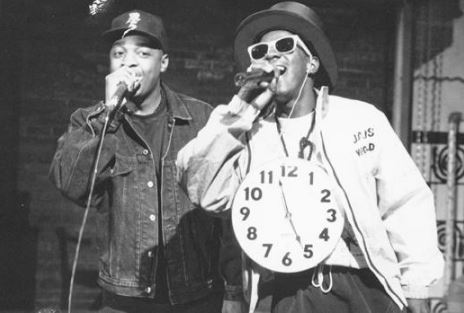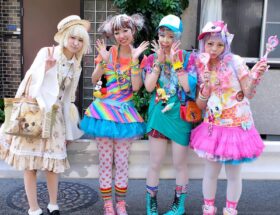Preamble to a Sartorial Symphony
Hip-hop and rap music, often perceived as the lyrical and rhythmic expressions of the urban narrative, have become profound vessels for cultural commentary and artistic evolution. Beyond their musical brilliance, these genres have given birth to a unique realm of fashion that transcends mere apparel. Lets embark on an intellectual journey to explore the complex history of fashion in hip-hop and rap, examining its evolution and its status as a high culture.
Chapter 1: Origins of Hip-Hop and the Roots of Style
1.1 The South Bronx Genesis (1970s)
At its heart, hip-hop was a response to the socio-economic challenges faced by African American and Latinx communities in the South Bronx during the 1970s. It was born from an amalgamation of art forms, including rap, breakdancing, graffiti, and DJing. As the cultural revolution unfolded, so did a distinctive sense of style.
1.2 Streetwear as Identity
In these early days, streetwear wasn’t just clothing; it was identity. B-boys and B-girls wore functional garments that allowed them to express themselves physically through dance. Baggy pants, oversized t-shirts, and sneakers provided the canvas for this kinetic art form.
Chapter 2: The Graffiti of Fashion and Logomania
2.1 Urban Canvases (1980s)
The 1980s saw the emergence of graffiti as an art form intertwined with hip-hop culture. Artists adorned clothing, often denim jackets and jeans, with hand-painted graffiti. This was not merely a fashion statement; it was a declaration of artistic freedom.
2.2 Logomania and Brand Identity
Simultaneously, the era saw the rise of logomania. This obsession with branded clothing was a reflection of the aspirational nature of hip-hop culture. Brands like Adidas, Nike, and Kangol became synonymous with the movement.
Chapter 3: Streetwear’s Metamorphosis into High Art
3.1 Luxury Brands and Streetwear (1990s)
The 1990s witnessed an intriguing convergence of streetwear and luxury brands. A generation that had grown up with hip-hop was now reaching the age of conspicuous consumption. Luxury brands began collaborating with hip-hop artists, merging street cred with high fashion.
3.2 Dapper Dan’s Vision
Dapper Dan, a Harlem-based designer, rose to prominence in this era by creating custom clothing featuring logos from luxury brands. His bold and extravagant designs catered to hip-hop’s desire for opulence while challenging fashion’s traditional boundaries.
Chapter 4: Sneakers: Footwear as Art
4.1 Run-DMC and the Adidas Superstar (1980s)
The 1980s brought forth a seismic shift in sneaker culture. Run-DMC’s hit song “My Adidas” transformed the humble Adidas Superstar into a symbol of hip-hop unity and defiance.
4.2 Air Jordans: A Cultural Phenomenon
The Air Jordan sneaker line, introduced by Nike in 1985, not only revolutionized sneaker culture but became an art form in itself. The fusion of high-quality design, basketball prowess, and marketing genius made Air Jordans the embodiment of hip-hop fashion.
4.3 Sneaker Collaborations and the Hypebeast Era (2000s-Present)
Sneaker culture evolved into the hypebeast era, with limited-edition releases and collaborations reaching a frenzied pitch. Collaborations like Kanye West’s Yeezy line and Travis Scott’s Air Jordans have elevated sneakers to artistry.
Chapter 5: Intellectual Influence of Hip-Hop Fashion Icons
5.1 Run-DMC: The Pioneers
Run-DMC not only popularized the Adidas Superstar but also introduced a minimalist and utilitarian style that would become emblematic of hip-hop’s intellectual elegance.
5.2 Notorious B.I.G.: The Stylish Storyteller
The Notorious B.I.G.’s penchant for Coogi sweaters, Kangol hats, and Versace shades represented a literary approach to fashion. His style was a visual narrative, mirroring his lyrical storytelling.
5.3 Missy Elliott: The Avant-Garde Visionary
Missy Elliott defied conventions with her colorful and eccentric style. Her music videos became sartorial spectacles, challenging societal norms and expanding the boundaries of high fashion.
5.4 Kanye West: The Architect of Transformation
Kanye West has left an indelible mark on hip-hop fashion through collaborations with brands like Nike and adidas. His transformative impact has pushed the boundaries of high fashion and streetwear.
Chapter 6: The Intellectual Language of Gender Fluidity
6.1 A$AP Rocky: Challenging Gender Norms
A$AP Rocky has been at the forefront of embracing gender-fluid fashion. His style blurs the lines between masculinity and femininity, challenging traditional norms within the genre.
6.2 Young Thug: Fashion as Self-Expression
Young Thug’s bold fashion choices, including wearing dresses, challenge preconceived notions of masculinity. His style serves as a testament to the intellectual depth of self-expression.
6.3 Tyler, the Creator: Eccentric Individualism
Tyler, the Creator’s eccentric style challenges conventional ideas of masculinity. His fearless approach to fashion reflects a nuanced understanding of self-identity and self-expression.
Chapter 7: Global Reverberations and the Impact of Hip-Hop Fashion
7.1 Streetwear as a Global Phenomenon
Streetwear, born from hip-hop, has transcended geographical and cultural boundaries. Enthusiasts worldwide have embraced this intellectual fashion language, fostering global streetwear communities.
7.2 African Influence in Hip-Hop Fashion
African artists and designers have contributed to the global hip-hop fashion scene, integrating traditional African fabrics and aesthetics into contemporary streetwear.
7.3 Streetwear in High Fashion
Luxury fashion houses now incorporate streetwear elements, further blurring the lines between high fashion and street culture. These collaborations have elevated streetwear to the realm of high art.
Conclusion: The Confluence of Hip-Hop Fashion and High Culture
Hip-hop and rap music have evolved far beyond their humble beginnings in the Bronx. Through a journey marked by graffiti, streetwear, luxury collaborations, and gender fluidity, hip-hop fashion has emerged as a powerful form of high culture. It speaks a language of individuality, defiance, and intellect, resonating with a global audience. As hip-hop continues to evolve, its influence on fashion will remain an intellectual dialogue that transcends generations and continues to shape the cultural landscape.









